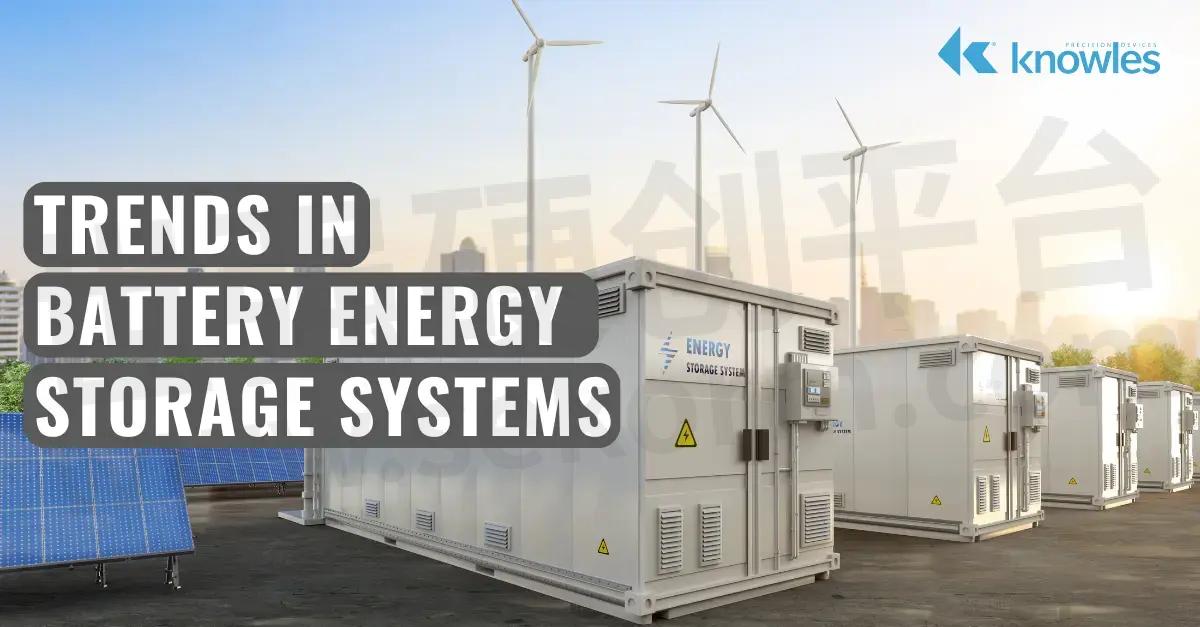Trends in Battery Energy Storage Systems

Battery energy storage systems (BESS) are named for their function. They capture, accumulate, and store energy in rechargeable batteries to be discharged later. Industrial facilities, homes, electric vehicles (EVs) and the like rely on these systems for backup power and operational efficiency.

While systems have different monitoring and control units depending on the application and operating conditions, the main components of a BESS include:
●Battery System: Contains battery cells arranged into battery packs; responsible for converting chemical energy into electrical energy
●Battery Management System (BMS): Monitors, balances, and protects the battery system to ensure its longevity, safety, and efficiency
●Inverter or Power Conversion System (PCS): Converts the direct current (DC) produced by batteries into alternating current (AC) to power homes and facilities; bi-directional inverters accommodate both charging and discharging
●Energy Management System (EMS): Monitors and controls the energy flow in the battery storage system by coordinating the work of the BMS, PCS, and other BESS components to manage power resources effectively
Advantages and Challenges for Utility-Scale Battery Energy Storage Systems (BESS)
In context, we’re seeing a growing desire for stable, reliable renewable energy paired with international conflicts impacting the price and availability of gas. Under these conditions, utility-scale BESS presents several unique advantages over other energy storage means.
By nature, BESS is modular and scalable. They offer an avenue for cost-effective, efficient grid expansion, so it’s easier to adapt to changing energy needs. BESS features frequency stabilization, voltage support, backup power, and black-start capability, so they can support independent restarts too.
Today, the photovoltaic and wind energy markets, BESS and EV chagrining infrastructure needs are experiencing mutual growth. For example, with the help of BESS, households and facilities on the grid can maximize their use of self-generated PV energy to lower energy bills and increase energy independence. In addition, wind farms use BESS to create hybrid systems that can help balance power supply and demand to provide consistent energy output regardless of the intermittency of wind.
While there are significant benefits to consider, there are technical challenges associated with developing and operating these systems too. Utility-scale BESS requires high-reliability converters with maximum uptime to deliver on expected grid stability and efficiency. Additionally, as wind and photovoltaic systems begin to operate at higher voltages (e.g., 1.5kV), BESS must be capable of supporting them.
At the components level, BESS requires high reliability and high voltage film capacitors to support these power systems over time, regardless of their operating conditions. For a deeper read on component selection, read our white paper, Power Conversion Capacitors for Harsh Environments.
- +1 Like
- Add to Favorites
Recommend
- Exxelia Film Capacitors Designed for Medical and Railway Applications Now Benefit from Reduced Delivery Times
- Analysis on the Application of Film Capacitors in Electromagnetic Heating Equipment
- EXXELIA‘s Film Capacitors Helped NASA‘s Perseverance Robot with Measuring and Sampling on Mars
- Exxelia to Show Latest Innovations in Film Capacitors and Magnetic Components at SIAE 2023
- Exxelia Unveils Two Brand New High Temperature Film Capacitors Series Operating up to 200°c
- Does a Manufacturer Specializing in Film Capacitors Still Have Any Future at All Compared to a Broadliner?
- The Film Capacitors Supplier Shenzhen CRC New Energy Announced a Distribution Agreement with Sekorm
- Is the Film Capacitor a Discontinued Model?
This document is provided by Sekorm Platform for VIP exclusive service. The copyright is owned by Sekorm. Without authorization, any medias, websites or individual are not allowed to reprint. When authorizing the reprint, the link of www.sekorm.com must be indicated.



























































































































































































































































































































































































































































































































































































































































































































































































































































































